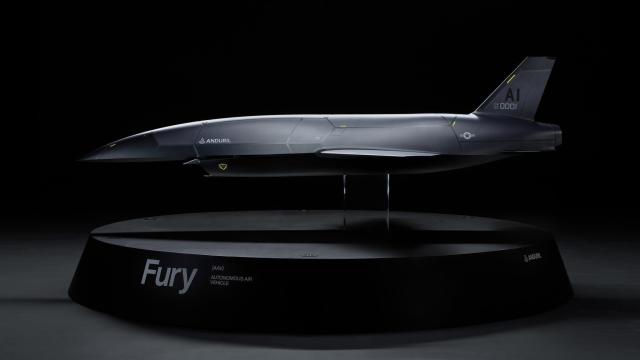Palmer Lucky, the Trump-thumping founder of the Oculus virtual reality headset is diving into the world of autonomous military aircraft. On Thursday, Anduril, Lucky’s venture-funded military tech company, unveiled its new AI-enabled, autonomous, fighter-jet-looking aircraft, which the company has dubbed “Fury.” Anduril says it plans to integrate Fury into its “Lattice” AI surveillance system, which is currently being deployed at the US border to serve as a “virtual wall.” Anduril’s announcement comes amid a renewed push by the US Department of Defense to acquire cheap, new AI systems at scale.
The Fury aircraft was actually designed and manufactured by another company called Blue Force Technologies, which Anduril officially acquired on Thursday for an unknown amount. Anduril defines Fury as a group-5 level (that’s the highest level) autonomous aircraft capable of “fighter-like performance.” Anduril says the aircraft, which is capable of reaching speeds over 700 miles per hour, can be equipped with a wide variety of sensors and payloads depending on mission requirements. Based on that description, it appears Fury could be deployed for both surveillance and combat operations. In a press release, Anduril pointed to the US Department of Defense as a potential partner.
“These new capabilities are critical to maintaining deterrence in an era of strategic competition,” the company said. “To project force, deter aggression, and regain affordable mass, the DoD will need to rely on large quantities of smaller, lower-cost, more autonomous systems.”
“Its [Anduril’s] objective is to support Department of Defense and allied militaries services in fielding autonomous and artificially intelligent systems as fast as possible,” the company added.
DoD spokesperson Jeff Jurgensen told Gizmodo the agency could not comment when asked whether or not it had been approached by Anduril regarding the Fury aircraft.
“The Department does not comment on specific M&A cases or potential, future contract actions,” Jurgensen said. “As a result, we have no information or statement to provide.”
Anduril did not immediately respond to Gizmodo’s request for comment.
Anduril attempting to cash in on the AI arms race
Anduril’s plans to integrate the Fury aircraft into its Lattice system, which functions as an AI-driven control center that oversees many of its connected military tech tools. Human operators, according to an Anduril blog post, can log into Lattice to control teams of robotic assets. The company believes this collection of autonomous systems working in tandem can comb through data faster, and more accurately than human operators. A version of Lattice is currently integrated into a collection of hulking surveillance towers sprawled out across the US, Mexico border. Customs and Border Patrol uses over 100 of those towers to surveil border crossers.
Though it’s unclear whether or not the US military wants to procure Anduril’s Fury aircraft in particular, Pentagon leaders have generally expressed a desire to ramp up the military’s autonomous capabilities. During a speech this week, first spotted by The Wall Street Journal, DoD Deputy Secretary of Defense Kathleen Hicks said the Pentagon intends to spend hundreds of millions of dollars in the coming years to produce a fleet of thousands of air, land, and sea-based AI systems. The initiative, dubbed Project Replicator, is intended as a means to maintain a technological edge with the Chinese military.
“We’re not at war,” Hicks said during the speech. “We are not seeking to be at war, but we have to be able to get this department to move with that same kind of urgency because the PRC [People’s Republic of China] isn’t waiting,”
The DoD isn’t new to autonomous systems. DARPA, the Pentagon’s ambitious research and development wing has spent decades paving the way for advancements in self-driving cars, autonomous helicopters, and even autonomous, dog-fighting fighter jets. Still, critics have accused the agency of moving slowly to deploy these systems in active combat operations due to cost and ethical concerns over AI accountability. But that somewhat cautious approach could be primed to shift.
In a recent interview with Breaking Defense, Lucky said he believes the recent cultural explosion of interest in AI brought on by OpenAI’s ChatGPT has increased interest in Anduril’s AI military tech by government leaders and politicians once reluctant to embrace, or uninterested in technology.
“It sounds crazy, but it’s just been so true,” Lucky said. “There’s so many people in the Pentagon and on Capitol Hill who have had that come to Jesus moment just because of the hype cycle around ChatGPT, which I am very happy to leverage in getting them excited about the future.”
